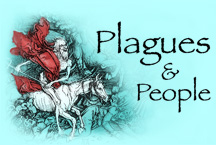
Infectious and Epidemic Disease in History
Department of History
University of California, Irvine
Instructor: Dr. Barbara J. Becker

Department of History
University of California, Irvine
Instructor: Dr. Barbara J. Becker
| Supplementary readings for Week 8's lectures include excerpts
from:
Cholera--
Poliomyelitis (Infantile Paralysis)--
Sometime in late summer or early autumn of 1831, a terrifying "new" disease arrived in Sunderland, England, probably on a ship from Hamburg. For over a decade, uneasy Britons had been hearing horror stories about it from friends and family living in India. If these stories were true, the disease they called "Asiatic cholera" spread like wildfire, causing many of its victims to succumb in as little as twelve hours from uncontrollable vomiting and diarrhea. When Sunderland officials finally attributed one of several recent local deaths to cholera on October 23 of that year, all hope was dashed that the disease would remain merely a distant and exotic threat. Indeed, it was already on its way to Newcastle, Edinburgh, London, and Dublin, from which city it would continue its deadly journey across the Atlantic.
The search for answers to these questions led Robert Koch (1843-1910) to discover that diseases like anthrax (1876), tuberculosis (1882), and cholera (1883) were spread through contact with infectious microbial agents. So when, in the summer of 1916, thousands of New York City children fell victim to a new epidemic form of an old disease known as "infantile paralysis," medical researchers sought to isolate and identify the responsible, yet elusive, microbe. Knowing what needed to be done didn't make the task any easier.
|
 |
| Go to: |
|